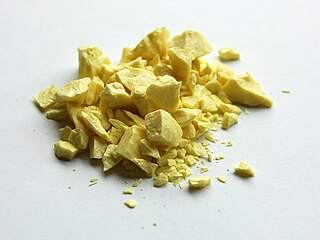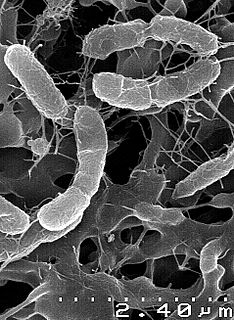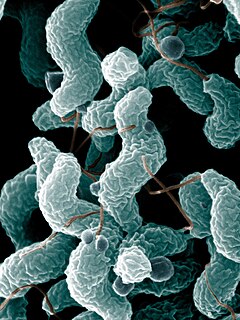Related Research Articles

Sulfur (in traditional lay Commonwealth English: sulphur) is a chemical element with the symbol S and atomic number 16. It is abundant, multivalent and nonmetallic. Under normal conditions, sulfur atoms form cyclic octatomic molecules with a chemical formula S8. Elemental sulfur is a bright yellow, crystalline solid at room temperature.

Sulfuric acid (American / IUPAC spelling) or sulphuric acid (traditional / British spelling), also known as oil of vitriol, is a mineral acid composed of the elements sulfur, oxygen and hydrogen, with molecular formula H2SO4. It is a colourless and viscous liquid that is miscible with water at all concentrations.

Sulfur dioxide or sulphur dioxide is the chemical compound with the formula SO
2. It is a toxic gas responsible for the smell of burnt matches. It is released naturally by volcanic activity and is produced as a by-product of copper extraction and the burning of fossil fuels contaminated with sulfur compounds. Sulfur dioxide has pungent smell like nitric acid.
A period 3 element is one of the chemical elements in the third row of the periodic table of the chemical elements. The periodic table is laid out in rows to illustrate recurring (periodic) trends in the chemical behaviour of the elements as their atomic number increases: a new row is begun when the periodic table skips a row and a chemical behaviour begins to repeat, meaning that elements with similar behavior fall into the same vertical columns. The third period contains eight elements: sodium, magnesium, aluminium, silicon, phosphorus, sulfur, chlorine, and argon. The first two, sodium and magnesium, are members of the s-block of the periodic table, while the others are members of the p-block. All of the period 3 elements occur in nature and have at least one stable isotope.

The green sulfur bacteria (Chlorobiaceae) are a family of obligately anaerobic photoautotrophic bacteria. Together with the non-photosynthetic Ignavibacteriaceae, they form the phylum Chlorobi.

Sulfurous acid (also Sulfuric(IV) acid, Sulphuric acid (UK), Sulphuric(IV) acid (UK)) is the chemical compound with the formula H2SO3. There is no evidence that sulfurous acid exists in solution, but the molecule has been detected in the gas phase. The conjugate bases of this elusive acid are, however, common anions, bisulfite (or hydrogen sulfite) and sulfite. Sulfurous acid is an intermediate species in the formation of acid rain from sulfur dioxide.

In biochemistry, chemosynthesis is the biological conversion of one or more carbon-containing molecules and nutrients into organic matter using the oxidation of inorganic compounds or ferrous ions as a source of energy, rather than sunlight, as in photosynthesis. Chemoautotrophs, organisms that obtain carbon from carbon dioxide through chemosynthesis, are phylogenetically diverse. Groups that include conspicuous or biogeochemically-important taxa include the sulfur-oxidizing gamma and epsilon proteobacteria, the Aquificae, the methanogenic archaea and the neutrophilic iron-oxidizing bacteria.
Acidithiobacillus is a genus of the Acidithiobacillia in the "Proteobacteria". The genus includes acidophilic organisms capable of iron and/or sulfur oxidation. Like all "Proteobacteria", Acidithiobacillus spp. are Gram-negative. They are also important generators of acid mine drainage, which is a major environmental problem around the world in mining.

Disulfuric acid or pyrosulfuric acid, also named oleum, is an oxyacid of sulfur. It is a major constituent of fuming sulfuric acid, oleum, and this is how most chemists encounter it. It is also a minor constituent of liquid anhydrous sulfuric acid due to the equilibria:
Permanganic acid (or manganic(VII) acid) is the inorganic compound with the formula HMnO4. This strong oxoacid has been isolated as its dihydrate. It is the conjugate acid of permanganate salts. It is the subject of few publications and its characterization as well as its uses are very limited.
Sulfur-reducing bacteria are microorganisms able to reduce elemental sulfur (S0) to hydrogen sulfide (H2S). These microbes use inorganic sulfur compounds as electron acceptors to sustain several activities such as respiration, conserving energy and growth, in absence of oxygen. The final product or these processes, sulfide, has a considerable influence on the chemistry of the environment and, in addition, is used as electron donor for a large variety of microbial metabolisms. Several types of bacteria and many non-methanogenic archaea can reduce sulfur.Microbial sulfur reduction was already shown in early studies, which highlighted the first proof of S0 reduction in a vibrioid bacterium from mud, with sulfur as electron acceptor and H2 as electron donor. The first pure cultured species of sulfur-reducing bacteria, Desulfuromonas acetoxidans, was discovered in 1976 and described by Pfennig Norbert and Biebel Hanno as an anaerobic sulfur-reducing and acetate-oxidizing bacterium, not able to reduce sulfate. Only few taxa are true sulfur-reducing bacteria, using sulfur reduction as the only or main catabolic reaction. Normally, they couple this reaction with the oxidation of acetate, succinate or other organic compounds.In general, sulfate-reducing bacteria, are able to use both sulfate and elemental sulfur as electron acceptors. Thanks to its abundancy and thermodynamic stability, sulfate is the most studied electron acceptor for anaerobic respiration that involves sulfur compounds. Elemental sulfur, however, is very abundant and important, especially in deep-sea hydrothermal vents, hot springs and other extreme environments, making its isolation more difficult. Some bacteria – such as Proteus, Campylobacter, Pseudomonas and Salmonella – have the ability to reduce sulfur, but can also use oxygen and other terminal electron acceptors.

Epsilonproteobacteria are a class of Proteobacteria. All species of this class are, like all Proteobacteria, Gram-negative.

A chemical substance is a form of matter having constant chemical composition and characteristic properties. Some references add that chemical substance cannot be separated into its constituent elements by physical separation methods, i.e., without breaking chemical bonds. Chemical substances can be simple substances, chemical compounds, or alloys. Chemical elements may or may not be included in the definition, depending on expert viewpoint.
A polysulfane is a chemical compound of formula H2Sx, where x > 1, although sometimes disulfane, H2S2 is excluded. Polysulfanes consist of unbranched chains of sulfur atoms terminated with hydrogen. Compounds containing 2–8 concatenated sulfur atoms have been isolated, longer chain compounds have been detected, but only in solution. H2S2 is colourless, higher members are yellow with the colour increasing with the sulfur content. Even a trace of alkali will cause chemical decomposition, and containers need to be treated with acid to remove any traces of alkali.
In the chemical literature the term polysulfanes is sometimes used for compounds containing −(Sn)−, e.g. organic polysulfanes R−(Sn)−R.

Thiosulfate dehydrogenase is an enzyme that catalyzes the chemical reaction:

The element sulfur exists as many allotropes. In number of allotropes, sulfur is second only to carbon. In addition to the allotropes, each allotrope often exists in polymorphs, delineated by Greek prefixes.

Hydrogen disulfide is the inorganic compound with the formula H2S2. This hydrogen chalcogenide is a pale yellow volatile liquid with a camphor-like odor. It decomposes readily to hydrogen sulfide (H2S) and elemental sulfur.
Thermothrix azorensis is a Gram-negative, facultatively chemolithoautotrophic, non-spore-forming, aerobic, thermophilic, sulfur-oxidizing bacterium of the genus Thermothrix, isolated from a hot spring on Sao Miguel Island in the Azores. T. azorensis uses thiosulfate, tetrathionate, hydrogen sulfide, and elemental sulfur for its sources of energy (chemolithoautotrophic).

Sulfur dibromide is the chemical compound with the formula SBr2. It is a toxic gas.
Ovaliviridae is a family of viruses of archaeal bacteria that is not assigned to any higher taxonomic ranks. The family contains a single genus, Alphaovalivirus, which contains a single species, Sulfolobus ellipsoid virus 1. The linear genome of dsDNA is 23,219 bp with 172 bp inverted terminal repeats. Sulfolobus ellipsoid virus was isolated from an acidic hot spring in Laguna Fumarolica, Costa Rica; the only known host is Sulfolobus sp. A20.
References
- ↑ bacterio.net Archived September 22, 2013, at the Wayback Machine
- ↑ http://web2.uwindsor.ca/courses/biology/fackrell/Microbes/12150.htm
- ↑ Brannan, DK; Caldwell, DE (1980). "Thermothrix thiopara: Growth and Metabolism of a Newly Isolated Thermophile Capable of Oxidizing Sulfur and Sulfur Compounds". Appl Environ Microbiol. 40 (2): 211–6. PMC 291554 . PMID 16345601.
| | This Betaproteobacteria-related article is a stub. You can help Wikipedia by expanding it. |